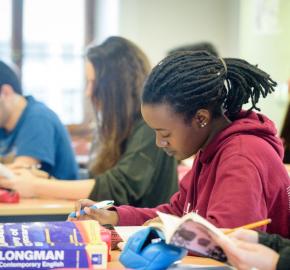
When it comes to expertise, the Global Fund is an international leader on two fronts: philanthropy and accelerating the end of the world’s most ravaging epidemics such as HIV, tuberculosis and malaria. One of its most well-known private sector partnerships is (RED), an innovative consumer marketing initiative that enables everyday people to use their purchasing power to help fight HIV. To learn more about what (RED) tells us about the evolution of grassroots philanthropy in a new era marked by global pandemics and human solidarity, we spoke with Maria Sol Pintos Castro at the Global Fund.
Could you please tell us more about yourself and your role in this colossal activation campaign?
I lead the Resource Mobilization team of the Private Sector Engagement Department at the Global Fund. I have spent more than 10 years at the Global Fund, leading and managing the work on philanthropic engagement, focusing on major multi-stakeholder partnerships with leading consumer marketing initiatives like (RED), faith-based organizations, trusts and foundations, corporations and HNWIs.
(RED) is the Global Fund flagship partnership. This incredible initiative was founded in 2006 with one singular purpose – to engage businesses and people in one of the greatest health emergencies, the AIDS pandemic. By partnering with the world’s most iconic brands to raise money for the Global Fund through (RED)-branded goods and experiences, (RED) partners empower consumers to contribute to the fight by purchasing and participating, with partner contributions from (RED) campaigns going directly to the Global Fund to fund vital health programs and services.
To date, (RED) has generated almost $700 million for the Global Fund to support HIV/AIDS grants, primarily in Ghana, Kenya, Lesotho, Rwanda, South Africa, Tanzania and Zambia, impacting over 180 million people.
Today, as the world faces the COVID-19 pandemic, (RED) is more committed than ever to the fight. To date, (RED) has generated over $14 million to the Global Fund COVID-19 Response Mechanism to help provide critical treatment, testing and tools to fight outbreaks and support life-saving programs and services that are relevant in any pandemic, whether HIV/AIDS or COVID-19.
(RED)’s 15 years of experience in partnering with the private sector demonstrates very clearly the important role played by companies, with millions of lives impacted thanks to the funds raised by our partners. And it’s not just money… it’s leverage. When companies care, governments have to care too and vice-versa. And that’s when you see public-private efforts at their best. The Global Fund in action is a perfect example of this.
Since (RED)’s launch, you saw the impact of philanthropy and how choosing a product or service can actually save lives. How have you seen grassroots philanthropy change over the last few years and what changes do you predict for the years to come?
Grassroots philanthropy and philanthropy in general have evolved in the last decade or so, the key changes are mostly around impact, transparency and digital technology. The latter is a critical underpinning that provides a more effective mechanism to give and deliver more impact and in a more transparent manner.
For years we have seen the evolution of grant making organizations focusing on being more strategic in their giving, driven by the direct impact of their support and as a result of more demanding donors’ community. It’s not only about how many people are served or saved, but about the behavioural and life changes needed and expected to ensure sustainable and real change.
Also, the move from paper to online has been transformational. Social media has led to a higher degree of public awareness and empathy for the philanthropic needs of nonprofits.
Equity, justice, and power are some of the key drivers in today’s world of social good and philanthropy. The role of the society has been fundamental in the way philanthropy is currently perceived. Social movements inspired by a more engaged society looking at affecting longer term change is the best shot for more resources and power in philanthropy, which can then catalyse social change.
Which factors have made and will continue to make a difference in inciting people to give or commit to philanthropic actions?
I would continue to say that sense of purpose, impact and transparency are the key features for people to care and give. Transparent information and impact play a pivotal role for philanthropy. Building trustful relationships, networks and collaboration are the key elements of solidarity and that combined with rigorous ways of measuring the impact of any donor’s gift in both the short- and long-term is what ultimately will continue to drive the giving.
The COVID-19 pandemic has shown us that there is no business as usual and the philanthropy community has resources and power that can and should be further unlocked in support of social good. If there is a time for philanthropy to consider permanently accelerating the pace and volume of giving, that time is now.
Is there anyone who is disrupting or innovating in philanthropy that we should look out for?
The COVID-19 pandemic has shown us how quickly donors and foundations teams have been working around the clock to reinvent themselves, drawing upon their missions and purpose to support this unprecedented crisis. There is certainly a renewed sense of purpose and, with that, the opportunity to reshape priorities for what will be the next world of giving, in this case, more specifically for Global Health/Health Security. The challenge is how to ensure these reshaped set of priorities are here to stay and the basis of the work that lies ahead.
I think another key takeaway from this pandemic for the philanthropy world is the importance of how giving measurements should be more in line with the dollar amount deployed today than the dollar amount spent in the future. Although more and more philanthropists have committed to giving their wealth away in their lifetime, this is still far from the actual dollar spent vs dollar committed.
In a world where the next normal would be to build a more sustainable environment which has been highly impacted by this pandemic, accelerating the pace and volume of giving is fundamental. A great example of transparent, accelerated and burden-reduced for grantees giving is Jack Dorsey, co-founder of Twitter and Square, who announced last April that he would give away $1bn of his wealth through his initiative Start Small. I believe he has given away more than $90 million for COVID-19 relief so far disclosing each gift in real time on a public spreadsheet. This is innovation and also a proof that making change in your lifetime is possible and certainly more effective.
Could you share with us an inspiring story of philanthropy you have experienced that might give us the courage and capacity to get into philanthropy ourselves?
I am convinced we are all philanthropists in some way or another. If we care we help and if we help, we want to see change.
We have a great story at the Global Fund that belongs to the staff. At the Global Fund, we have GOAL, an employee giving campaign. Through GOAL and basically by selling roses for Valentine’s day or bake sales for Halloween, we have managed to support the education of HIV positive kids and young adults in Africa. They have been able to continue their studies thanks to this support. One of the stories we are all very proud of is the story of two young men in Zambia who have recently graduated from the Law and Medical school. This is a story of hope, resilience and humanity.
We can all make a difference in the world we live in and that is great for society.




